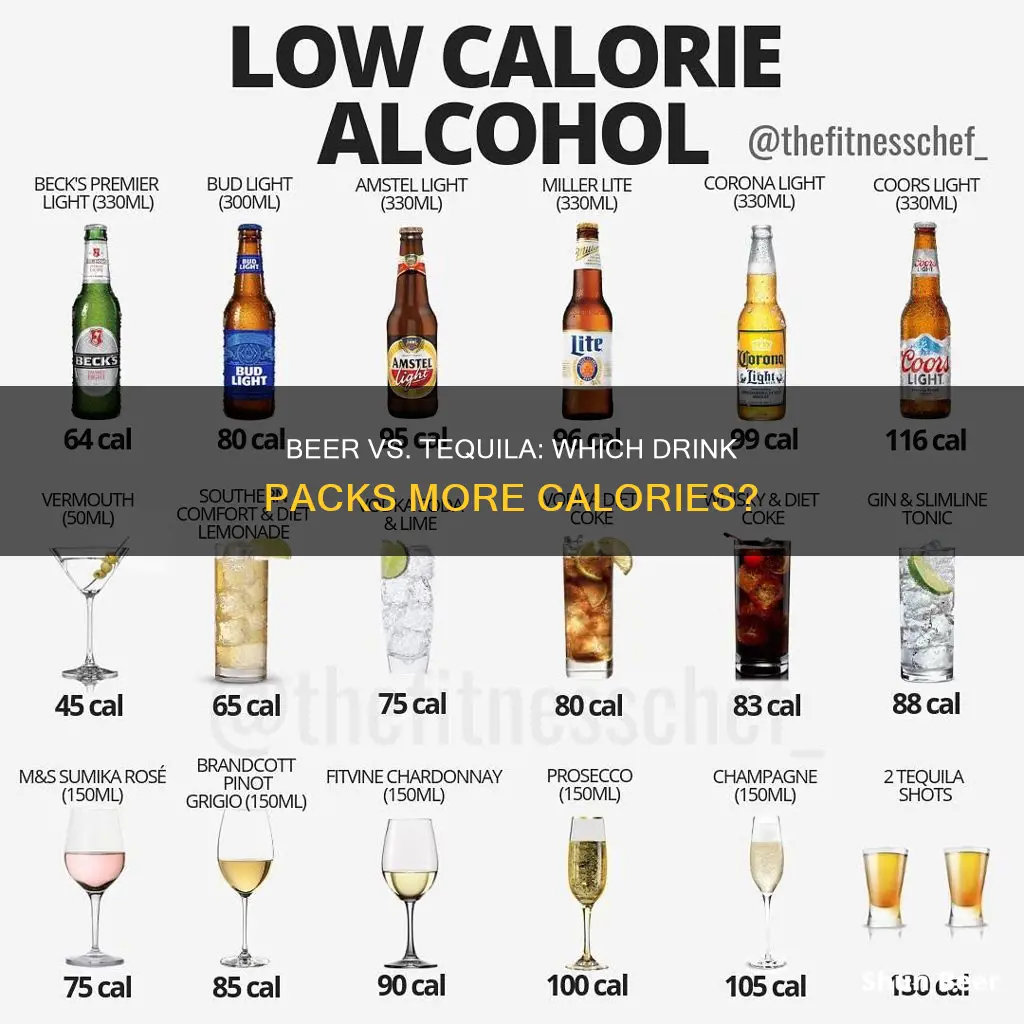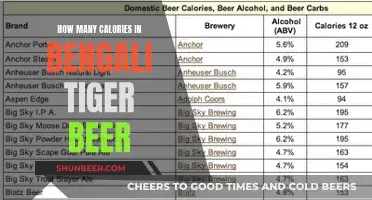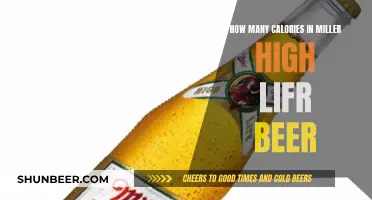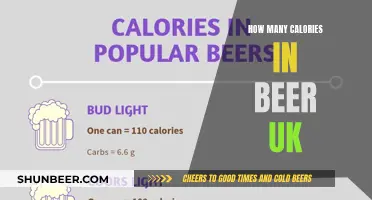
Alcoholic drinks can be a significant contributor to your daily calorie intake. A 2012 study found that the average American adult consumes 100 calories a day from alcoholic beverages. Tequila and beer differ in their calorie content. A 1.5-ounce shot of tequila contains around 97 to 100 calories, while a 12-ounce beer contains approximately 140 to 150 calories. Therefore, tequila has fewer calories per serving than beer. However, it's important to note that the calorie content of alcoholic beverages can vary depending on their alcohol content, volume, and additional ingredients or mixers.
| Characteristics | Values |
|---|---|
| Calories in a shot | Beer: 60-150; Tequila: 97-120 |
| Calories in a pint | Beer: 140-250; Tequila: N/A |
| Calories in a glass | Beer: N/A; Tequila: 100 |
What You'll Learn

Beer calories depend on alcohol content and carbs
A beer's calories depend mostly on its alcohol content and, to a lesser extent, its carbohydrate content. Pure alcohol contains 7 calories per gram, which is less than a gram of fat (9 calories) but more than protein and carbs (4 calories per gram each). The amount of alcohol, the total volume of the beverage, and the amount of carbohydrates and sugars all play a role in determining the calorie count.
Generally speaking, the biggest difference in calories in beverages comes from the alcohol content. However, the presence of carbohydrates in alcoholic beverages also contributes significantly to their calorie count. Dwayne Bershaw, who teaches winemaking classes in the Department of Food Science at Cornell University, explains that leftover carbohydrates from the brewing process contribute to the overall calorie count for most beers.
Low-calorie beers have an additional enzyme added during the brewing or fermentation process that breaks down all the starch molecules into simple sugars, leaving no remaining carbohydrates. These beers also have a relatively low alcohol content to keep the total calorie count low.
The calorie content of beer can vary depending on the type and brand. For example, very low-alcohol beers (2% to 3% alcohol) like Miller 64 start at around 60 calories per 12 oz. Most light beers (4% alcohol) have about 100 calories, while an average 5% alcohol brew like Budweiser has around 150 calories. Heavy hitters (7% to 11% alcohol) like regular IPAs, double or imperial IPAs, and Belgian-style Trippels can pack 200 to 300 calories.
Beer vs Wine: Which Drink is Lower Calorie?
You may want to see also

Tequila is lower-calorie, but mixers add calories
A standard 1.5-ounce shot of tequila contains around 100 calories, while a 12-ounce beer has about 150 calories. So, if you're looking at pure tequila versus beer, tequila is the lower-calorie option. However, it's important to consider what tequila is mixed with, as mixers can add significant calories.
Tequila is often served in cocktails, such as margaritas, which can contain up to 400 calories, depending on the recipe and size of the drink. Sugary mixers, like syrup, soda, juice, and cream, are common in cocktails and can quickly increase the calorie count. For example, a classic margarita made with tequila, lime, and triple sec has around 200 calories in a small glass.
To keep the calorie count lower when drinking tequila, opt for fresh fruit juices or low-calorie mixers like soda water, diet tonic, or seltzer. Straight tequila or a tequila shot with a squeeze of lime juice is also a lower-calorie option.
Additionally, the alcohol content and volume of the drink can impact the calorie count. Higher-alcohol beers, such as IPAs, can contain 200 to 300 calories, while low-alcohol beers start at around 60 calories for a 12-ounce serving. Similarly, "cask strength" or "overproof" liquors can have slightly more calories than standard tequila shots.
While tequila may have fewer calories than beer, it's important to remember that both alcoholic beverages provide little to no nutritional value. Consuming too much alcohol can hinder weight loss efforts and contribute to weight gain. Therefore, it's important to enjoy these beverages in moderation and be mindful of the mixers and ingredients used.
Calories in Beer vs. Wine: Which Has More?
You may want to see also

Beer has more calories than wine
It's easy to forget that alcoholic drinks contain calories, but they can quickly add up. A 2012 study found that the average American adult consumes 100 calories a day from beer, wine, or other alcoholic beverages.
When it comes to beer and wine, beer generally has more calories. A typical 12-ounce beer has about 140-150 calories, which is similar to a can of Coke. The calorie content of beer depends mostly on alcohol content and, to a lesser extent, on carbs. Very low alcohol beers (2% to 3% alcohol) start at around 60 calories, while most lights (4% alcohol) have about 100 calories. An average 5% alcohol beer has around 150 calories, and heavy hitters (7% to 11% alcohol) can pack 200 to 300 calories.
On the other hand, wine typically has fewer calories. A 5-ounce glass of red wine has about 120 to 125 calories, and a 6-ounce pour, which is common in restaurants, has around 150 calories. Even higher-sugar white wines like Moscato or Riesling are in the same range. Lighter wines can have as few as 70 to 80 calories per 5-ounce glass.
The difference in calories between beer and wine primarily comes from the leftover carbohydrates in beer, as the sugar content in most wines is fairly low. Beer is made from grain, which stores carbohydrates in the form of starch. During the brewing process, these starches are broken down into smaller pieces, and some larger pieces remain that cannot be converted into alcohol, contributing to the overall calorie count. Low-calorie beers have additional enzymes added to break down all the starch molecules, resulting in no remaining carbohydrates and a lower alcohol content.
While beer generally has more calories than wine, it's important to note that the specific calorie content can vary depending on the type of beer and wine, as well as other factors such as alcohol percentage and serving size.
Beer Calories: Friend or Foe to Your Diet?
You may want to see also

Cocktails are high-calorie due to sugar content
Cocktails are often high-calorie due to their sugar content. While pure alcohol contains 7 calories per gram, other variables influence the calorie count of a drink. The amount of alcohol, the total volume of the beverage, the amount of carbohydrates, sugars, and mixers all play a role.
Cocktails typically contain spirits, liqueurs, juices, syrups, or other mixers, all of which can contribute to the overall calorie count. Spirits like vodka, tequila, rum, and gin have the lowest calories, with around 95-120 calories per 1.5 oz serving. However, when used in cocktails, the calorie count can increase significantly. For example, a margarita or pina colada can have close to 500 calories per drink, depending on the size and ingredients used.
Mixers and other additives are often the main sources of sugar and calories in cocktails. Ingredients like tonic water, juice, soda, syrups, cream, and coconut can pack sugar and fat calories on top of the alcohol content. Even fruit juices, which contain natural sugars, can increase the calorie count of a cocktail.
To make lower-calorie cocktails, one can opt for low-calorie mixers, such as sugar-free syrups, lemon or lime juice, bitters, or diet soda. Using spirits like vodka, tequila, rum, or gin can also help reduce the calorie count. Additionally, choosing low-calorie alcohols, such as light beer or reduced-calorie wine, can be a good option.
While it's challenging to avoid all calories and sugar in cocktails, being mindful of the ingredients and making informed choices can help individuals maintain a healthy lifestyle while still enjoying their favourite drinks.
Calories in Sour Monkey Beer: Nutritional Breakdown
You may want to see also

Low-calorie beers use an additional enzyme to reduce calories
A standard shot of tequila (1.5 oz) has around 97 to 120 calories, while a typical 12 oz beer has around 140 calories, roughly the same as a can of Coke. However, the calorie content of beer varies depending on the type and brand of beer. For example, Budweiser has around 150 calories, while Budweiser Select 55 has only 55 calories per serving.
Low-calorie beers are made by reducing the carbohydrate and alcohol content. Alcohol contains 7 calories per gram, while carbohydrates contain 4 calories per gram. Therefore, lowering the amount of alcohol and carbohydrates in beer can significantly reduce its calorie content.
One way to reduce the calorie content of beer is to add an additional enzyme during the brewing or fermentation process. This enzyme breaks down dextrins, which are complex sugar molecules that remain intact during the brewing process and contribute to the overall calorie count of the beer. By breaking down these dextrins into simpler sugars, the beer's caloric content is lowered.
There are a few different methods for adding these enzymes to the beer. One method is to extend the mashing process, allowing the natural enzymes in barley to break down more of the carbohydrate material into simple sugars. Another method is to add exogenous brewing enzymes to the mash or fermenting beer, which breaks down most or all of the carbohydrates into fermentable sugars. After dilution with water, a light or low-calorie beer is obtained.
Critics of low-calorie beers argue that they sacrifice flavour and are often watered down. However, some people prefer the more subtle and less brassy taste of low-calorie beers. Additionally, brewers have made significant innovations in recent years, allowing them to create low-calorie beers that retain the taste people love.
Calories in Wild Craft Beer: Gourd's Gone Wild
You may want to see also
Frequently asked questions
It depends on the volume of the drink. A 12-ounce beer has around 140-150 calories, while a 1.5-ounce shot of tequila has around 97-110 calories. Therefore, a larger beer will have more calories than a standard shot of tequila, but a smaller beer will have fewer calories.
The calorie count of an alcoholic drink is influenced by the amount of alcohol, the total volume of the beverage, the amount of carbohydrates, sugars, and mixers.
Some lower-calorie alcoholic drink options include light beer (around 100 calories), champagne (around 84 calories per 4 ounces), dry wine (approximately 120-125 calories per 5 ounces), and spirits like vodka, gin, rum, or whiskey (around 100 calories per 1.5-ounce shot).
To reduce your calorie intake when drinking alcohol, choose drinks with lower alcohol content, avoid sugary mixers, and practice mindful drinking by sipping and savouring your drink instead of chugging it down. Alternating between alcoholic drinks and water can also help reduce your overall calorie intake.
Alcoholic drinks are a source of "empty" calories, meaning they provide calories without contributing to your daily nutrition. Consuming more calories from alcohol than you burn can lead to weight gain over time. For example, consuming 100 extra calories per day can result in a weight gain of 10 pounds over a year.







